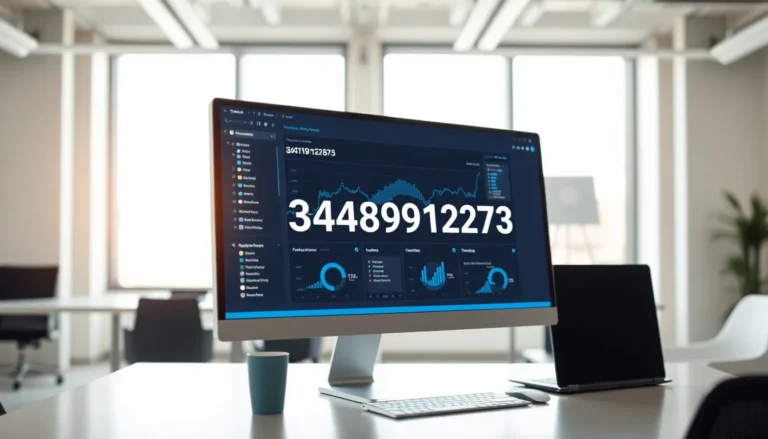Receiving calls from unknown numbers can be frustrating, especially when the caller ID shows “No Caller ID.” These mysterious calls often lead to unwanted interruptions and can even be a source of anxiety. Fortunately, there are effective ways to block these calls and regain control over your phone.
In this article, readers will discover straightforward methods to block No Caller ID calls on various devices. Whether it’s through built-in phone settings or third-party apps, they’ll learn how to create a more peaceful communication experience. By taking these simple steps, anyone can minimize distractions and protect their privacy.
Table of Contents
ToggleUnderstanding No Caller ID
No Caller ID refers to incoming calls that do not reveal the caller’s phone number. Such calls often create confusion and concern about the caller’s identity.
What Is No Caller ID?
No Caller ID indicates a call that masks the caller’s information. Telecommunication services allow users to block their personal numbers for various reasons, leading to an anonymous call. This feature applies to individuals using landlines and mobile devices, enabling privacy during communication.
Why Do People Use No Caller ID?
People use No Caller ID for various reasons, including:
- Privacy Protection: Individuals may wish to keep their number confidential during personal or sensitive conversations.
- Business Use: Companies sometimes call clients or customers without disclosing their direct line to maintain a level of professionalism or confidentiality.
- Telemarketers and Scammers: Some telemarketers and scammers exploit No Caller ID to avoid detection and bypass call blocking mechanisms.
Understanding the implications of No Caller ID helps individuals make informed decisions about managing these types of calls effectively.
Methods to Block No Caller ID

Blocking No Caller ID calls can enhance privacy and reduce distractions. Here are two effective methods for managing these unwanted calls.
Using Built-In Phone Features
Most smartphones offer built-in features to block No Caller ID calls, providing users with a straightforward solution.
- iPhone: Go to Settings > Phone. Enable “Silence Unknown Callers.” This feature automatically sends calls from unknown numbers to voicemail.
- Android: Access the Phone app, tap on the three-dot menu, and select “Settings.” Choose “Block numbers,” then enable “Block anonymous calls” or enable Call Screening for recent Android models, which filters out No Caller ID calls.
Third-Party Apps for Blocking
Numerous third-party apps exist for blocking No Caller ID calls, allowing for customizable solutions.
- Truecaller: This app identifies unknown numbers and blocks spam calls. Users can enable the blocking of No Caller ID numbers through settings.
- Hiya: Hiya offers call blocking features and caller ID identification, allowing users to filter out unwanted calls effectively.
- Mr. Number: This app blocks calls from specific numbers, including No Caller ID calls. Users can customize the blocking settings based on their preferences.
Utilizing these methods can significantly reduce the annoyance of No Caller ID calls.
Service Provider Options
Service providers offer various options to block No Caller ID calls, ensuring a more secure calling experience. Users can utilize carrier services in conjunction with device features for optimal results.
Contacting Your Carrier
Contacting the carrier provides users direct assistance for managing No Caller ID calls. Most carriers, such as Verizon, AT&T, T-Mobile, and Sprint, have customer service representatives who can enable specific blocking features for a user’s account. Some carriers may offer services like call blocking or caller ID enhancements that reduce or eliminate unwanted calls. Users can inquire about options specific to their provider and request the activation of these services.
Available Blocking Services
Available blocking services differ among carriers and may include various features. Here are some common options:
- Call Block Services: Some carriers offer services that block calls from specific numbers, including those marked as No Caller ID.
- Robocall Protection: Many carriers provide caller identification tools that detect and block suspected spam calls.
- Carrier-Specific Apps: Some telecom companies offer proprietary apps that help users block unwanted calls and manage their contact lists.
- Premium Services: Certain carriers feature premium services that allow users to block No Caller ID calls with enhanced accuracy and additional filtering options.
Exploring these carrier options can help users reclaim control over their incoming calls and improve overall privacy.
Tips for Effective Blocking
Effective blocking of No Caller ID calls enhances personal privacy and reduces unwanted disruptions. Implementing the right strategies can significantly improve the calling experience.
Reporting Unwanted Calls
Reporting unwanted calls helps authorities track and address unwanted communication. Users can report No Caller ID calls to their service provider or the Federal Trade Commission (FTC).
- Collect Information: Note the date, time, and frequency of calls for accurate reporting.
- Use Carrier Services: Many carriers provide dedicated channels for reporting unwanted calls. Utilize these resources to notify the provider.
- Engage with Apps: Certain third-party apps offer reporting features. Users can submit No Caller ID calls directly through these platforms for further action.
Keeping Your Phone Updated
Keeping devices updated ensures access to the latest features designed to block unwanted calls. Regular updates enhance security and introduce new functionalities for call management.
- Check for Software Updates: Regularly navigate to the settings to verify if software updates are available. Install updates promptly for optimal performance.
- Update Apps: Frequently update third-party call-blocking apps to ensure they have the latest filtering capabilities and databases.
- Explore New Features: Manufacturers often add advanced call blocking features in updates. Review available options in device settings to utilize enhanced tools for blocking No Caller ID calls.
Conclusion
Blocking No Caller ID calls is essential for maintaining personal privacy and reducing unwanted interruptions. By utilizing built-in phone features third-party apps and service provider options users can effectively manage these calls. It’s crucial to choose the method that best fits individual needs and preferences. Staying proactive by reporting unwanted calls and keeping devices updated further enhances the ability to filter out disturbances. With these strategies in place individuals can regain control over their communication experience and focus on what truly matters.








